Most media coverage of the spring 2024 student protests for a free Palestine misses the most important element: hope.
Students hope to bring greater attention to Israel’s war on Gaza. They hope to highlight their universities’ complicity with Israeli colonialism. And, in spite of the brutal police responses, they hope to inspire their fellow students.
They have succeeded wildly by capturing the world’s attention and sparking a youth movement that has gone global. Their calls for universities to divest from Israel have revived the Boycott, Divestment, Sanctions movement modeled on the campaign that helped topple South African apartheid. And, as student protests swelled, President Joe Biden for the first time delayed sending 3,500 bombs to Israel after authorizing more than 100 separate weapons shipments in the first five months after Oct. 7, 2023.
For more than a week I bicycled up and down Manhattan, visiting five universities where protest camps had sprouted. Conversations with dozens of students and supporters indicate a large swath of youth have been horrified and radicalized by the Israeli war and found hope in the protest camps they created, however brief.
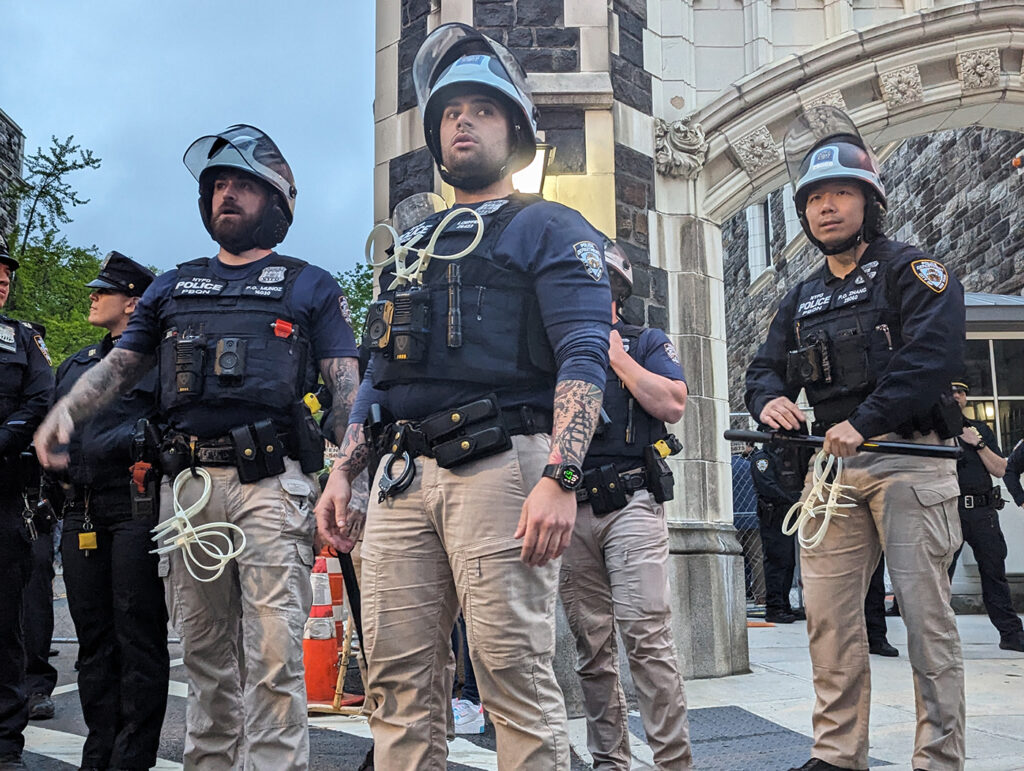
NYPD riot police prepare to move into the City College of New York the night of April 30. After barricading the campus located in upper Manhattan, police arrested 173 people breaking the bones and teeth of some protesters according to reports. Photo by Arun Gupta.
On April 22, in front of the New York University (NYU) Stern School of Business, I watched as the New York Police Department (NYPD) riot police evicted a peaceful protest camp just hours old and arrested more than 130 people, including students and faculty. Ryna Workman, 24, who is in their third year at the NYU School of Law, provided legal and logistical support for the protests and negotiated with university officials. They say, “These encampments are places of dreaming, of building better community. We see how we can be better and we hope for a future where that kind of community spreads everywhere.”
At Columbia University, on April 29, the day before the NYPD stormed the campus and evicted a student encampment for the second time in as many weeks, Jamil Mohamad, 32, spoke next to a camp of some 130 tents on the south lawn. A Ph.D. candidate in Middle Eastern history at Columbia, Mohamad says, “The encampment was really inspiring and created a community like I have never seen. It was a very beautiful expression of solidarity. Before that I was watching the genocide happening on my own, not knowing how to carry on with my life.”
At City College of New York, in the northeast reaches of Manhattan, hundreds of police outfitted with zip ties, batons, and ballistic helmets fenced off the campus on April 30. Before cops crushed the encampment that night, arresting at least 173 people, a student at the five-day-old protest said, “Some people are singing ‘The Internationale.’ Others are praying to Allah.”
Having covered social movements and increasingly violent police response for decades, I knew the camps would be steamrollered sooner rather than later. That was the fate of hundreds of Occupy Wall Street encampments that popped up in 2011, Occupy ICE in 2018, and Seattle’s Capitol Hill Organized Protest during the George Floyd movement.
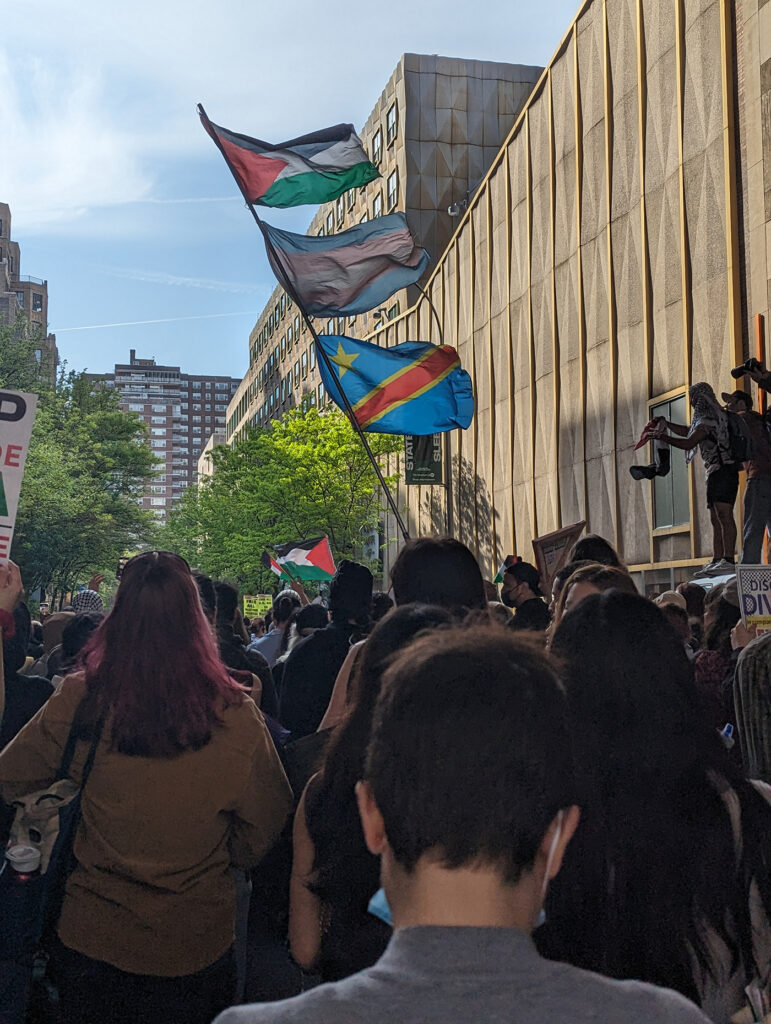
Hundreds of pro-Palestine protesters make their way to a student encampment at the Fashion Institute of Technology on April 30. Photo by Arun Gupta
Many students have been undeterred by universities siccing police on them. After being ejected from Stern, NYU students resettled two blocks away for a week before the police raided their new camp as well. At the New School, located a half mile north of NYU, teachers initiated the first faculty-led encampment on May 8 after police quashed a student protest on Fifth Avenue. At the Fashion Institute of Technology, located near the Garment District in Manhattan, the pro-Palestine camp sprung up after a student was suspended, thrown out of housing, and fired from her campus job for posting a flier about the Gaza war in an area approved for political speech, according to other student protesters.
This followed a pattern seen at campuses nationwide. At MIT, students tore down fencing to retake their camp despite threats of suspension. At Harvard University, the suspension of a student group spurred a takeover of the historic Harvard Yard. Students at the University of Texas at Austin kept protesting after police attacked a peaceful gathering with chemical spray, beatings, and stun grenades that can maim and kill.
Today’s student movement follows in the footsteps of Occupy Wall Street. In 2011, police repression of the camp a stone’s throw from the New York Stock Exchange caused the movement to spread around the world. As of May 6, Wikipedia tallied pro-Palestine protests and camps at almost 140 universities in 45 of 50 states and in 29 countries from Argentina to Yemen.
The catalyst for protests began when the University of Southern California announced on April 15 it was canceling the commencement speech of student valedictorian Asna Tabassum over “safety” concerns. The real reason seems to be that she was smeared by Zionists as antisemitic for being pro-Palestine. Then on April 17, Columbia University President and Baroness Minouche Shafik testified at Congressional hearings on antisemitism flanked by the co-chairs of the board of trustees. Before the hearing, 23 Jewish faculty warned that she would be joining in the “political theater of a new McCarthyism” seeking to destroy intellectual inquiry. Critics said Shafik “threw academic freedom under the bus” and revealed investigations of prominent professors who were unaware of the crosshairs trained on them. Hours before the hearing, Columbia students erected a Gaza Solidarity Encampment on campus. Once back on campus, Shafik authorized a “notoriously violent” NYPD force on April 18 to arrest more than 100 students. Perhaps Shafik thought she was putting a lid on the simmering anger. It blew up in her face.
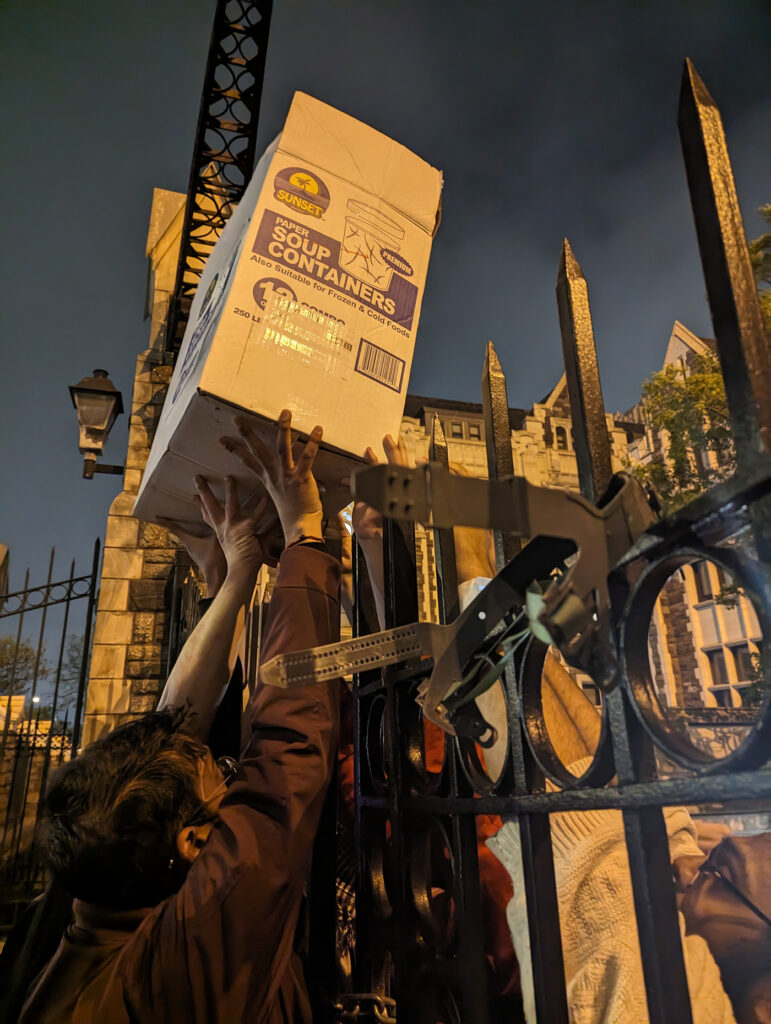
After hundreds of police blockaded the City College campus on April 30, supporters hoisted supplies over a locked gate to protesters inside. Photo by Arun Gupta
Sebastian Gomez, a Columbia senior, said police “swooped in from every side” as they arrested 108 students. Watching from his lab where he researches plasma physics, Gomez said it was “a terrifying experience.” But Columbia students poured out in support of the activists, reviving the camp within 24 hours. That day Gomez went from supporting the camp to joining it, saying before the April 30 crackdown, “This is a beautiful place with students from every walk of life supporting each other. We have seminars, teach-ins, and I am learning about so many things. People are bringing us wonderful food every day. I’ve eaten better than I have in months.”
Gomez showed me a chart that students created that was far more sophisticated than the “administration versus students” media narrative. Students portrayed the university as a right-wing institution controlled by wealthy trustees who oversee a $13.6 billion endowment fund that invests in “war profiteers” such as Lockheed Martin and Google. Students claim at least five trustees are tied to military contractors, the NYPD, and Zionist organizations that, in the words of the chart, “manufacture consent” for Israel. Shafik is just a hatchet man “intimidating” faculty and staff, calling in the NYPD to “punish” students, and doing the bidding of far-right politicians.
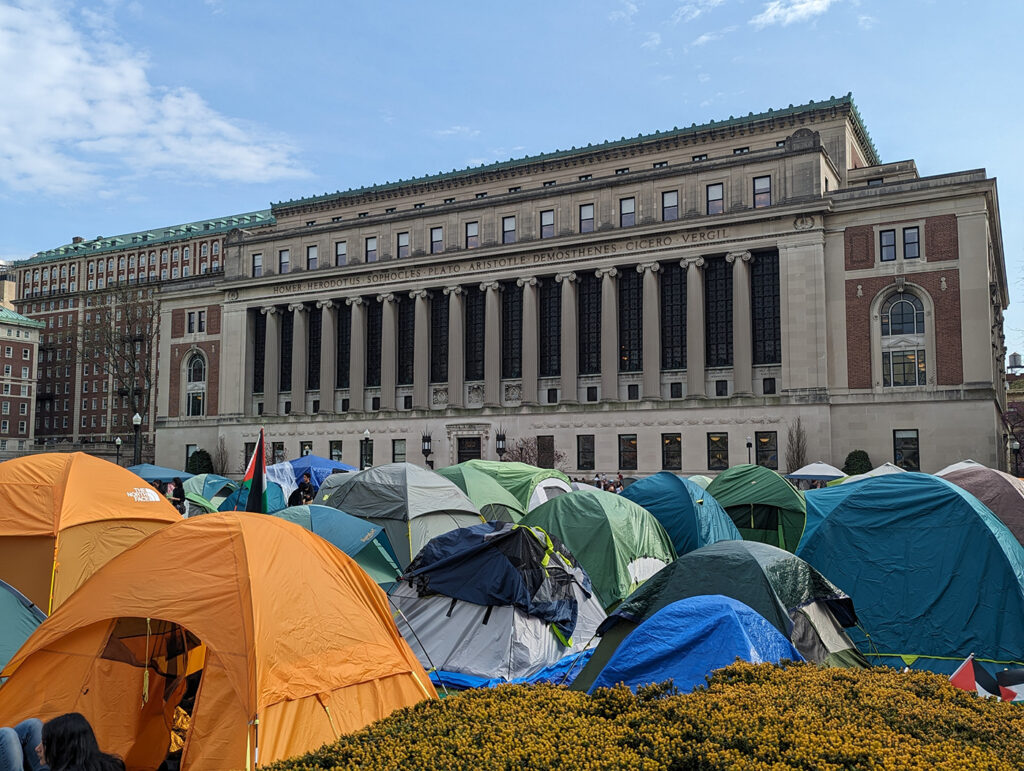
In front of the Butler Library, emblazoned with the names of ancient thinkers from Homer to Vergil, Columbia students erected their second peaceful protest camp in two weeks only to see it squashed by the university administration and NYPD. Photo by Arun Gupta
Columbia is so entangled in the web of maintaining Israeli power that the day after mass arrests at Columbia and City College, New York City Mayor Eric Adams said, “I really want to thank” Rebecca Weiner, the NYPD deputy commissioner of intelligence and counterterrorism, for “monitoring the situation.” Weiner also teaches at at Columbia’s School of International and Public Affairs, and at the press conference with Adams, she accused Columbia students of the “normalization and mainstreaming of rhetoric associated with terrorism that has now become pretty common on college campuses.”
Other heavyweights trying to strangle student dissent at Columbia include sports mogul, Trump financier, and Columbia University “megadonor” Robert Kraft who has bashed students with full-page ads in New York media while pumping millions of dollars into pro-Israel projects.
Despite facing such powerful opponents, Jamil Mohamed says, “Students were very optimistic about divestment happening. They really believe all the things they are demanding are possible.”
Darializa Avila Chevalier, who graduated from Columbia University in 2016, is also optimistic. A regular at the camp, she says Columbia is known as the “activist Ivy, where students can engage in demonstrations and speech.” The demands, says Avila Chevalier, “are incredibly reasonable, and the university has met them before.” That includes Columbia divesting from South Africa in 1985, private prison corporations in 2015, and fossil fuel companies a few years later.
Ryna Workman calls the 1968 protests at Columbia “the compass” for students today. That movement culminated in a police riot with over 700 arrests. Faculty and students went on strike in response, forcing Columbia to cancel its contract with a military-research outfit, the Institute for Defense Analyses, and scrap an athletic facility, dubbed “Gym Crow,” that would have displaced many Black residents near the university.
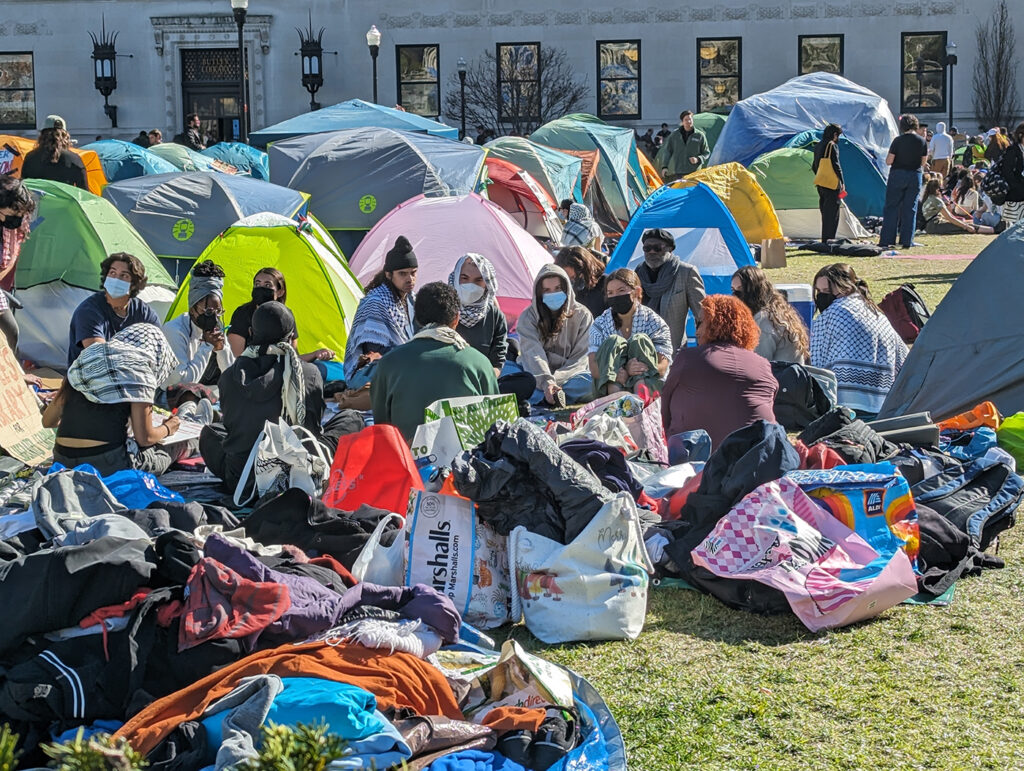
For the two weeks student protesters camped on the Columbia campus, teach-ins, trainings, and visits from author Norman Finklestein, Gazan journalist Motaz Azaiza, and politicians from Green Party presidential candidate Jill Stein to Rep. Ilhan Omar were an everyday occurrence. Photo by Arun Gupta
Today’s student activists rattle off influences from previous social struggles and are eager to learn from the past (unlike many Occupy Wall Street protesters who were allergic to history based on what I saw across the country). Workman says, “A lot of people were radicalized by the George Floyd movement,” and mention the anti-apartheid divestment movement as a model.
I cut my activist teeth helping build and occupy a shanty at the University of Maryland, Baltimore County in the late 1980s. By that point divestment from South Africa was inevitable. But when the economic campaign against apartheid first began in the 1960s it seemed impossible, much as the campaign to end Zionist colonialism may seem today.
This time around, the stakes are higher, repression more vicious, and politics more Orweillian than in earlier social movements. The free Palestine movement at Columbia was pummeled by pro-Zionist forces the moment it got off the ground after the Oct. 7 attacks. “Doxxing trucks” circled Harvard University on Oct. 11 and Columbia on Oct. 25. The trucks displayed electronic images of students with their names. Accuracy in Media, a right-wing outfit known for disinformation, was behind the trucks and published websites labeled “Columbia Hates Jews,” naming dozens of students.
Many students who were named were inundated with online harassment and death threats. One Columbia student, who didn’t identify themselves, said the administration amplified the hostility as it “suppressed and harassed students who voiced their support for the Palestinian people since October.” On Nov. 10, Columbia suspended chapters of Students for Justice in Palestine and Jewish Voices for Peace on thin procedural grounds.
The attacks they face echo what Palestinian civilians are facing from Israel. On Jan. 19, Columbia students holding a divestment rally claimed they were attacked with a noxious chemical sprayed by two individuals who also called protesters “Jew killers” and “self-hating Jews.” Palestinian students say they recognized the odor, a combination of sewage and rotting flesh, as “Skunk,” a chemical weapon used in the West Bank by Israeli forces. The university initially blamed the students for holding an “unsanctioned” rally. On April 3, Columbia suspended four students and gave them 24 hours to clear out of their housing for holding a webinar entitled “Resistance 101” with a Palestinian activist whom Zionists accuse of being a terrorist.
The repression of student protests is happening in a post-Trump world of surveillance, far-right mayhem, and disinformation. At Northeastern University in Boston, the administration listed “reprehensible antisemitic statements” as a rationale to use police force to rout a student protest camp there, arresting nearly 100 people. However, reporters found evidence that the incident involved a pro-Israel student demonstrator yelling “Kill the Jews,” apparently trying to provoke a large pro-Palestine gathering.
University administrators across the country have invoked technicalities on where, when, and how students are protesting to declare them in violation of codes of conducts. Many strict codes, however, were recently enacted to prevent pro-Trump extremists from bringing violence to college campuses. The codes, however, did not stop a pro-Israel mob at UCLA funded in part by Jessica Seinfeld, wife to tedious comedian Jerry Seinfeld, from attacking a pro-Palestine camp with fireworks, tear gas, pepper spray, and violent beatings that sent 25 students to the hospital. Various police forces watched for hours without intervening. But the university used the far-right violence as a justification to send in police the next day to brutalize student protesters, arresting more than 200 of them.
The melding of state and mob violence is a microcosm of Israel-Palestine, in which extreme right-wing settlers guarded by military units have been on the rampage since Oct. 7 in the West Bank, killing, ethnically cleansing, and seizing the land and property of the indigenous inhabitants.
Police violence is not inevitable. Authorities choose to allow peaceful dissent or crush it. At least six university administrations have agreed to some demands of student protesters without going from zero to police batons in an instant. The president of Wesleyan University in Connecticut wrote in The New Republic why he wasn’t sending in police. Brown University students in Rhode Island packed up tents after the university corporation agreed to a process and vote in October on whether or not to divest from Israel. Students at Rutgers University dismantled their camp after the administration agreed to eight of their 10 demands, although not divesting from Israel nor canceling plans to open a branch of Tel Aviv University in Rutgers tech hub in New Jersey. In Philadelphia, progressive district attorney and right-wing bane Larry Krasner helped keep police at bay from the University of Pennsylvania for more than two weeks. Krasner visited the then week-old protest camp on May 3. While talking of upholding the Constitution, Krasner said, “We don’t have to do stupid like they did at Columbia.”
The pro-Palestine student movement has displayed an admirable resilience, even in the face of violence and misinformation. The passion, discipline, and sophistication by students against all odds show they represent the best of humanity. Their opponents represent the worst of America.
ARUN GUPTA is a graduate of the French Culinary Institute and has written for the Washington Post, the Nation, The Daily Beast, The Raw Story, The Guardian, and other publications. He is the author of the upcoming Bacon as a Weapon of Mass Destruction: A Junk-Food-Loving Chef’s Inquiry into Taste (The New Press).
YES! Media is independent and nonpartisan. Our explanatory journalism analyzes societal problems in terms of their root causes and explores opportunities for systemic, structural change. Our stories uncover environmental, economic, and social justice intersections. Our solutions reporting spotlights the ideas and initiatives of people building a better world. Our commentaries address dominant economic, political, and social structures and consider alternative ways of thinking that can produce a more equitable and Earth-friendly world.

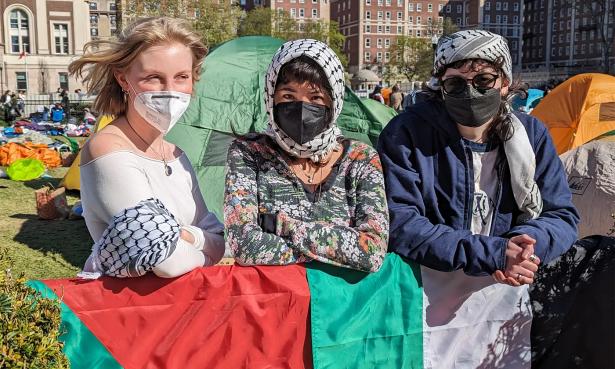
Spread the word